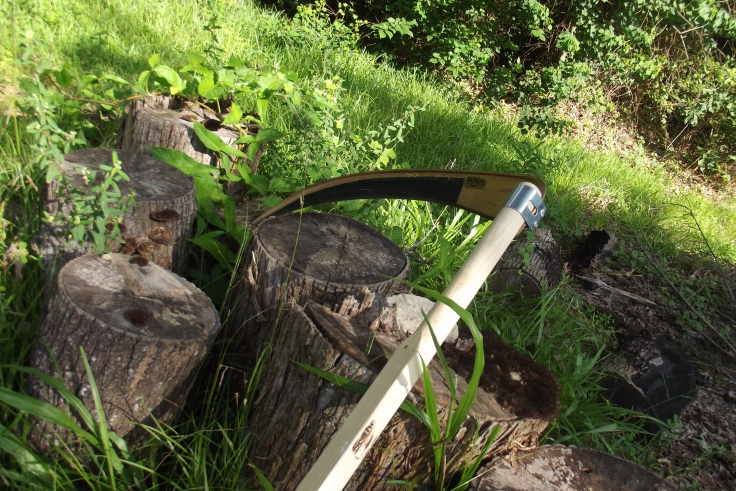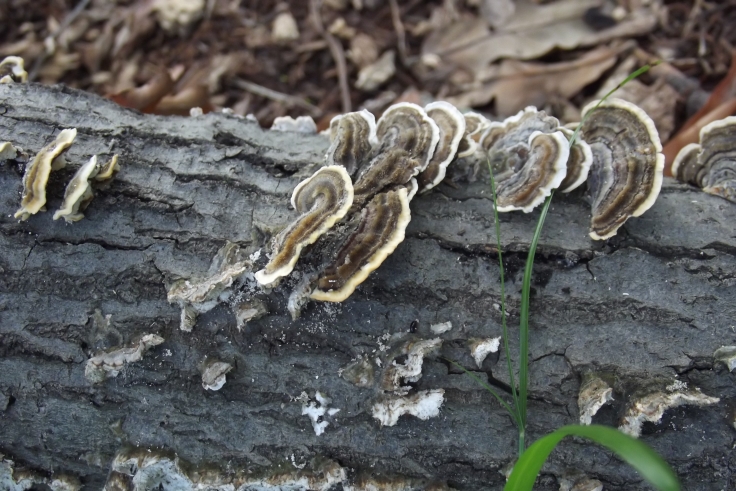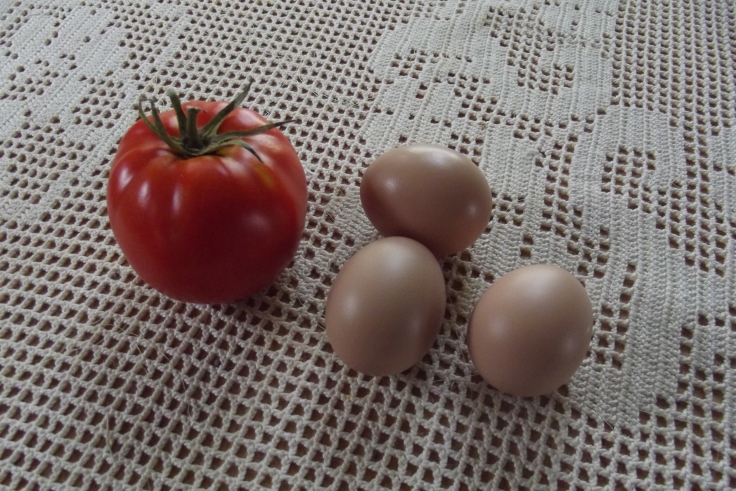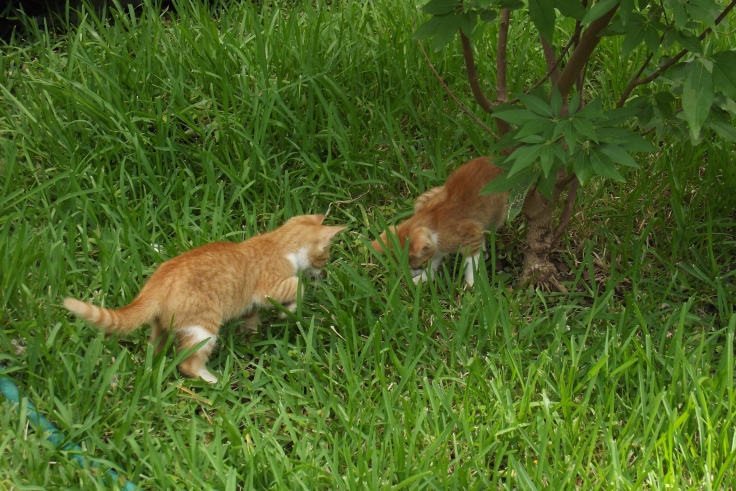 On Summer Solstice morning – Litha, for some of us – I took a long-handled scythe into the meadow garden. This area was set aside to allow the native sedges and other wild plants a place to grow and reseed themselves more-or-less without constraint. It’s intended to be mown once or twice a year, and the straw from the mowing will help provide mulch for the kitchen garden and later for use throughout the food forest area of the Hermitage land.
On Summer Solstice morning – Litha, for some of us – I took a long-handled scythe into the meadow garden. This area was set aside to allow the native sedges and other wild plants a place to grow and reseed themselves more-or-less without constraint. It’s intended to be mown once or twice a year, and the straw from the mowing will help provide mulch for the kitchen garden and later for use throughout the food forest area of the Hermitage land.
When I first floated the idea of mowing the meadow garden every now and then during a meditative walk through the area, probably around the summer solstice and autumn equinox, I had a sudden image of myself using a long-handled scythe to do the cutting. This is often how specific requests from my Patrons come, so I knew to take it seriously. I was also surprised. Honestly, I’d been intending to lug out the string trimmer. It would be fast and easy; the whole job could be done in an hour, tops. It wasn’t what They had in mind.
The next thought through my mind was: Where would I get such a thing? Does the universal “they” even make those anymore? Apparently, “they” do – in Perry, Maine, where they craft wooden snaths (the long handles) to their clients’ measurements and import blades from Austria and other places. The website is www.scythesupply.com. (Scythes are also available on Amazon, but with a price difference of only $20 or so, I went with the made to measure unit.)

That’s how I came to be in the meadow garden with a scythe on Summer Solstice morning. The scythe has been blessed as a tool, both for mundane and – in a broad sense – religious uses. It will be slower going than the string trimmer, but it’s in keeping with the general sense that electronics shouldn’t be in the meadow. The gentle swinging motion of mowing with a scythe is meditative, encouraging a contemplative attitude. Swing a few minutes, stop and touch up the blade with a whet stone, swing away again. I’m doing a little in the mornings and evenings, as time permits, and the fresh mulch goes directly on the kitchen garden beds.

The meadow garden is situated in the medial area of the Hermitage, between the cultivated garden beds and lawn and the wooded thicket at the rear of the lot. In permaculture terms the meadow garden would fall roughly into Zone 3, but with the caveat that, since this is where my altar and meditation area is located, it gets a bit more attention than a Zone 3 area generally would. Piles of sticks and fallen branches provide shelter and habitat for snakes, mice, and insects. After a heavy rain the low-lying areas briefly hold shallow pools of water that provide muddy homes for toads and skinks. The areas along the property lines to east and west of the meadow garden are hedge-rows where I’ve planted a couple of mulberry trees and some Solomon’s seal. Mustang grapes, yaupon, and honeysuckle grow wild under the protective shade of a few oaks and hackberry trees. There is also poison ivy and quite a lot of the shrimp plant that Mom unwisely tried to toss green into her passive compost bin some years back. I haven’t managed to find the bin, yet. The naturalized shrimp plant has taken it over. Beyond the meadow is the dewberry thicket, and beyond that are the woods.

The woods are a tiny copse of trees with a canopy dense enough that relatively little grows in the deep layer of leaf-mold at their feet. It’s actually easier to walk through the woods than through the neighboring thicket. Only a few spindly privets and thick rattan vines, spearing up straight from the ground and into the limbs of the oak trees, get enough light to grow here. I’ve been back there once in the past year, just after Mom died, to pinpoint the corner posts of the lot. The woods have been largely undisturbed since I moved away from home a little over thirty years ago, and are as close to a wilderness as can be found around here. Even so, the oldest tree there has likely been growing for no more than fifty to sixty years.
It’s questionable whether “wilderness” in the objective sense even exists. Archaeologist Sarah Parcak works with satellite imagery to map the remains of human settlements (sites) in Egypt. “What we’re finding is that everywhere you look there are sites.” This isn’t just true of Egypt. Deep in the Amazon rainforest, once thought to be pristine jungle, the remains of foraging camps dating back 13,000 years, and villages and ancient milpa terraces dating to 4,000 years ago are being identified. The truth that is slowly emerging is: there is not a single place on this Earth that has not been impacted by human activity in some way. If there is anything unique about humans as a species, it is that, for good or ill, we are a part of this world in a way that possibly no other single species can claim. Our species is imminently adaptable to environment, and where we can’t adapt, we alter the environment to our needs. It’s that very ability to adapt and to alter that has brought us to where we are, as a species, now.
One of the first lessons I learned about the nature of Litha was that it was a counter-point to Yule, the Winter Solstice. On the longest night and shortest day, we celebrate the Life we know is to come with the spring. On the longest day and shortest night, with the abundance of summer and the swelling and ripening of fruits and vegetables, we turn to acknowledge the first shadow of Death and the slow decline to winter. (This is, of course, not the only meaning attached to Litha; like most of the Sabbats, there are meanings on top of meanings.) Like the meadow garden, the Solstices are liminal spaces at the edges of other things. They are slightly uncomfortable places where we must pay attention a bit more to our surroundings, and are drawn to think uncomfortable thoughts and ask uncomfortable questions. These are the questions I feel drawn to contemplate: Are we, with our species spread out over the entire planet and at an all-time high in population, on the sharp leading-edge of our own extinction? Or are we on the cusp of a massive paradigm-shift in the way humans relate to the Earth and to Nature? Only time will tell.
In The Garden:

The long wait is finally bearing fruit, literally. All three of the tomato plants are producing lovely tomatoes, almost more than Loretta and I can eat comfortably. Sliced tomatoes are appearing on the table at practically every meal. One eggplant has produced two ripe, violet striped fruit that made a wonderful pasta sauce for one dinner, and a delicious stuffed eggplant for another. There are two long thin Louisiana Green eggplants still growing on one of the two plants. I have no idea when they’re ripe, but will be harvesting one of them soon. I’ve only had a single bell pepper and a single banana pepper from four plants, but I’m hoping for better as the summer continues.

The corn came into full flower in June and several ears have appeared along the stalks. Bees have been buzzing happily around the spiky heads. Or at least they were, before a series of wet days came along. The entirety of the White Eagle section of the corn patch has lodged – lain over – due to the wet soil. I’ll have to try hilling it next year. There isn’t so much lodging going on with the Glass Gem row, though whether that is because this variety is more resistant to lodging or because its location is more protected is unclear.
The Kentucky Wonder beans have been a disappointment. So far, they’ve produced a few spindly vines with a few flowers and a grand total of three beans. A work colleague suggested I try them in the fall garden, when the growing weather will be a bit cooler. I’ll set up a teepee for them in September.

A short crushed granite pathway has been added leading to the ramp into the shed, between the two oldest garden beds. It was a bit of an experiment. It’s turned out well, so I will eventually order a full load of the gravel so create pathways in the garden. It’s a bit of an expense, but not as much as laying pavers or brick.

A couple of the girls have laid their first small eggs! There are a good half-dozen in a bowl on the counter. I keep telling myself that I’m going to have to actually cook with them soon, rather than just admiring them.
In other parts of the garden, the Daylilies have been giving a succession of blooms throughout the month of June and into July. The tips of the Crepe Myrtles are drooping with bunches of fragrant blossoms. The potted Echinacea has been putting on quite a show this year. I’m planning on transplanting it next to the blueberries this fall so it will have more room to grow.
Around the Hermitage:
In preparation for the summer tropical storm and hurricane season, I purchased and installed a rain barrel near the Hermitage’s front door. I’ll add more to the collection over time. I’d like to add one in the garden near the shed. Being on the coast of the Gulf of Mexico, I have to be careful that they are tightly netted or my rain barrels will become mosquito nurseries. After our remarkably mild winter we have plenty of mosquitoes already without breeding more.

The weather is getting hotter and hotter as summer approaches, and working outside is becoming less possible except in the early morning or late afternoon close to dusk. I’m turning more to tasks inside the Hermitage. I have a number of small, easy jobs that have been waiting for the right time, and now it their moment, such as hanging the small stained-glass panel in the kitchen window.
And now, for a return to the edge of wild, but in the cutest way possible: the newest occupants of the space below the Hermitage’s back porch. The family of three kittens and a tortoise shell calico mother are mostly feral, but I’m slowly working on them. They’re getting kitten food and occasional pets as they learn to trust me more. Here are two of them, chasing a toad.








Those questions are think are being considered by a lot of people. Nature has a way of addressing imbalances and as a race we seem to have forgotten our place in the natural world. It’s so sad. I feel a combination of both those outcomes may emerge. Lovely way to describe the solstices (as at the edge etc) and yes they always do feel slightly uncomfortable.
LikeLiked by 1 person
Loving your photos of all the flowers
LikeLike
Thanks!
LikeLike